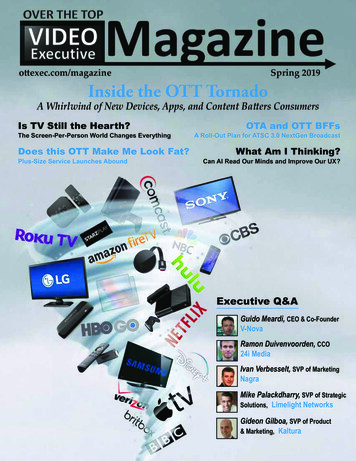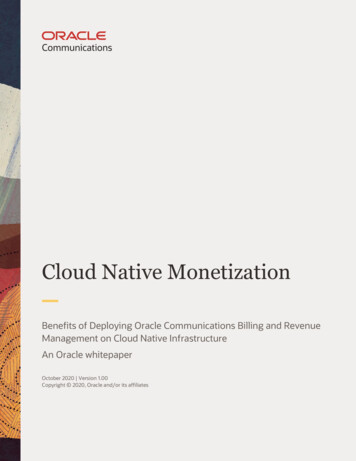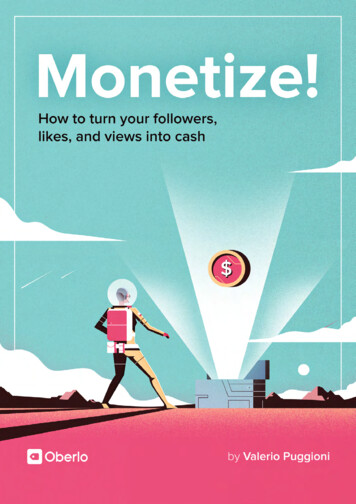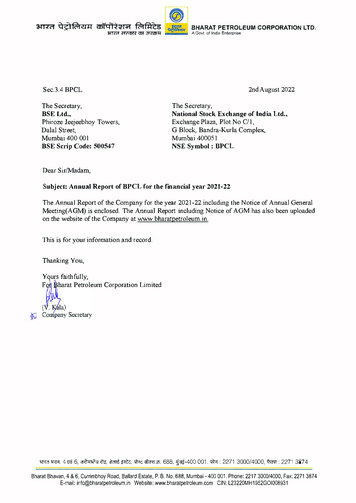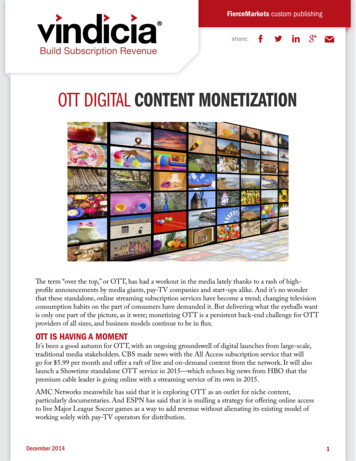
Transcription
OTT DIGITAL CONTENT MONETIZATIONFierceMarkets custom publishingshare:OTT DIGITAL CONTENT MONETIZATIONThe term “over the top,” or OTT, has had a workout in the media lately thanks to a rash of highprofile announcements by media giants, pay-TV companies and start-ups alike. And it’s no wonderthat these standalone, online streaming subscription services have become a trend; changing televisionconsumption habits on the part of consumers have demanded it. But delivering what the eyeballs wantis only one part of the picture, as it were; monetizing OTT is a persistent back-end challenge for OTTproviders of all sizes, and business models continue to be in flux.OTT IS HAVING A MOMENTIt’s been a good autumn for OTT, with an ongoing groundswell of digital launches from large-scale,traditional media stakeholders. CBS made news with the All Access subscription service that willgo for 5.99 per month and offer a raft of live and on-demand content from the network. It will alsolaunch a Showtime standalone OTT service in 2015—which echoes big news from HBO that thepremium cable leader is going online with a streaming service of its own in 2015.AMC Networks meanwhile has said that it is exploring OTT as an outlet for niche content,particularly documentaries. And ESPN has said that it is mulling a strategy for offering online accessto live Major League Soccer games as a way to add revenue without alienating its existing model ofworking solely with pay-TV operators for distribution.December 20141
OTT DIGITAL CONTENT MONETIZATIONTraditional pay-TV distributors are jumping intoo; Verizon Communications has said that it mayleverage its purchase earlier this year of Intel’sOnCue digital video assets, combining the telco’sFiOS IPTV and broadband offering with itsmobile assets. The resulting mobile OTT servicecould launch in the middle of 2015, and the telcois already in the latter stages of negotiations withthe major content providers ahead of the launch(Disney, NBCUniversal, Viacom, FOX, TimeWarner and so on).Pure-play OTT providers like Netflix and AmazonPrime, who have quickly taken on incumbency inthe market, continue to add subscribers as well,which ups the ante for the more traditional johnnycome-latelies. In fact, Netflix now has 36 millionsubscribers in the United States, compared topremium channel HBO’s 31 million, according toBloomberg.“This is changing so fast that many companies arejumping in, really just to get in, even if they don’thave a strategy yet,” said Fernando Elizalde, ananalyst in the consumer services and applicationsand consumer technology and markets divisions atresearch firm Gartner.And that lack of strategy is where the OTTdiscussion turns a bit darker.Netflix kicked off the idea of content streamingvia the Web back in 2008 with a partnership withStarz to offer an innovative service: on-demandstreaming video. And in the next two years it grewthe proposition, managing to kill off the movierental business as we knew it—RIP, Blockbuster.End users took to the service by the millions, andthat also drastically changed the traffic patterns forbroadband consumption; In fact, one could arguethat Netflix single-handedly has driven the massiveupgrades in residential broadband services acrossthe U.S. by cablecos and telcos alike.With better broadband comes better viewingexperiences for video, and more uptake. And so, farfrom a perfect storm of opportunity, what Netflixstarted six years ago has become a crowded oceanof streaming video competition. The most recenttsunami of planned launches will mean an evenDecember 2014FierceMarkets custom publishingbigger surfeit of consumer choice for programminghow and when they want it—but the reality is thatbusiness models have yet to shake out. Put simply,the Netflix model of offering third-party contenton demand across the Web is no longer enough tosupport a viable OTT business.OTT’S COMPETITIVE CHALLENGES LOOMThere’s a reason so many big names are jumpinginto the OTT space, business-model maturity aside.In 2014, the industry is projected to generate nearly 8.5 billion in the United States, according toPricewaterhouseCoopers. That is an increase of 102percent from 2009. PwC is also projecting that theOTT business in the U.S. will grow another 101percent between now and 2018, to total just over 17 billion in revenue.So, there is clearly opportunity in the market, butthe stick is equal to the carrot in this case when wedelve deeper into the competitive realities of themarket.“This is changing so fast that manycompanies are jumping in, really justto get in, even if they don’t have astrategy yet.”Fernando Elizalde, analyst in the consumerservices and applications and consumertechnology and markets divisions at researchfirm GartnerFor one, convincing consumers to opt for OTTexclusively—to cut the cord, as they say—iseasier said than done, for now. Despite chargingan average of 100 or more per month for basicentertainment, cable and other pay-TV segmentshave an advantage when it comes to consumerloyalty: access to premium channels like HBO, andexclusive access to things like major league sports.Especially in the latter case, the programmingrights are so expensive that no OTT provider could2
OTT DIGITAL CONTENT MONETIZATIONFierceMarkets custom publishingVINDICIA OTT MONETIZATIONSOLUTIONShope to monetize them on the back of a 7.99 permonth subscription—leaving it squarely in thepurview of traditional TV.To succeed in the rapidly evolving OTTmarketplace, providers need to offer morethan compelling content and reasonablevalue. To truly thrive, OTT providers mustcombine compelling content and value withenticing promotions, a broad reach, proactiveretention processes, scalability, and continuousimprovement.It’s no shock that CBS’ new service does notinclude live sports content.However, many OTT providers find thattraditional billing platforms can’t supportthose objectives in a subscription setting.For example, adding a simple refer-a-friendpromo to a traditional system can take weeks.Billing glitches lead to involuntary churn andreduced revenue streams. And OTT providerswith international rights should be able to sellglobally easily—but their billing systems mayhold them back.That’s why many successful OTT players aremonetizing their digital assets using provensubscription billing solutions from Vindiciathat allow them to: Create agile, subscription-based and VODbusiness models that respond to customerdemand.Also, traditional pay-TV provides other benefits,namely convenience. The set-top box (STB) actsas “input one”—and is an aggregation point fordisparate content sources. Watching OTT, onthe other hand, requires disconnecting the STBand plugging in some other box in order to getcontent on the big-screen TV, often at the mercyof whatever broadband connection is in place inthe home. And, considering that no one OTTservice has all of the content that a single pay-TVsubscription does, it’s likely that the consumerwould be toggling between apps and paying formultiple OTT subscriptions to simply approximatewhat cable gives them all in one place, within oneprogramming guide. Maximize recurring revenue throughpricing, packaging, bundling, campaigns andpromotions. Retain customers longer by implementingfrictionless payment strategies that reducesubscriber churn. Leverage subscriber analytics to gainknowledge about their customers andunderstand key trends, thereby enablingfaster and improved decision-making.Vindicia offers two solutions: VindiciaCashBox, a complete subscriber acquisition,billing and retention platform; and VindiciaSelect, a customer retention solution thatworks with any existing billing system toresolve failed payment transactions. Bothsolutions were created from the premise thatThis is being played out in macro-trends: Accordingto the latest informitv Multiscreen Index, the totalnumber of subscribers across the top 10 pay-TVservices was up by over 400,000 year-on-year as of–3–
OTT DIGITAL CONTENT MONETIZATIONFierceMarkets custom publishingAugust 2014, and by more than 1.5 million overtwo years.strategic monetization is critical not justas an operational necessity for successfulOTT service models, but also as a marketingresource that strengthens customer acquisitionand retention.Overall, OTT has been largely complementary toexisting cable, satellite and IPTV subscriptions sofar—and that means that a household is not likelyto subscribe to more than one ancillary service.A subscriber has either Hulu Plus OR Netflix,Amazon Prime OR VUDU. So slicing up that 17billion revenue pie may end up being an exercise inextreme fragmentation, as more choices enter themarket.VINDICIA CASHBOXBut what about the 10 million broadband-onlyhomes in the U.S.? That’s a figure that’s growing:Some 75 percent of U.S. homes have a broadbandservice, and of those broadband homes, 14.1 percentdid not use a traditional pay-TV service in thirdquarter 2014. That’s up from 8.6 percent three yearsearlier, according to research firm The DiffusionGroup.In a similar vein, it’s clear that OTT will becomemore crucial as millennials continue to move intothe video market. Consumers under 30 are muchless likely to value a cable subscription than theirolder counterparts, so while the pay-TV pictureremains good for now, traditional operators willnot be able to hang onto success in the longterm. According to nScreenMedia, 19 percent ofmillennials are living without pay-TV; out of those,98 percent say they have no intention of getting it.Vindicia CashBox is a comprehensive, SaaSbased subscription billing and recurringpayment platform specifically designedfor dynamic subscription business modelsfavored by OTT service providers. Thesolution features integrated marketing andbest practices that boost customer acquisitionand optimize customer retention. CashBoxlets OTT service providers quickly changepricing, introduce new bundles, supportSVOD and one-time sales, launch flexibletrial entry programs, and reach new audiencesthrough coupons or promotion codes.With CashBox, content owners, cable/satelliteoperators, and broadcasters/networks lookingto capitalize on the growing popularity ofOTT services can take full control of theirnew business models with detailed analyticsand best practices to grow and sustain newrevenue streams.VINDICIA SELECTFor OTT providers who already have abilling system in place, Vindicia Select isan add-on solution that increases OTTsubscriber retention to drive higher revenueand customer lifetime value. IncorporatingVindicia’s patent-pending AdvancedRetention Technology (ART ), VindiciaSelect heals failed payment transactions,thereby dramatically reducing involuntarychurn. The solution allows OTT providers to:So this looks like a greenfield opportunity on thesurface, but again, it’s an open question as to howmany under- 10 subscriptions these consumersare willing to pay for before the approach becomesa drag on their wallets (and patience). They mayultimately opt for a basic cable service or may gowith just one or two OTT options.And finally, it must be noted that companiesjumping into OTT need to walk a very fineline between cannibalizing their bread-andbutter revenue sources and capturing additionalopportunities. Media companies are concernedabout alienating or undercutting existingdistribution partners (i.e., pay-TV operators), whilethose same operators must be careful to protecttheir own subscription and advertising revenues. Reduce involuntary churn by about 30% ormore Boost revenue by as much as 5% Increase customer lifetime value throughimproved retention Improve customer service by keepingcustomers connected to OTT services–4–
OTT DIGITAL CONTENT MONETIZATIONAMC’s OTT concept is a long-tail play, forinstance. Its top-flight network content, like MadMen and the Walking Dead, will stay right where itis, on the cable channel’s linear, on-demand and TVEverywhere outlets.Conversely, start-ups/Web companies who jump infull-force to the online-only proposition effectivelylimit their wider options with bigger distributors.Apple, for instance, has been pursuing a relationshipwith pay-TV for years to become the middlewareon STBs—a concept that cable and media alikehas categorically refused to entertain because ofthe potential competitive ramifications in allowingApple to control the user experience inside thehome.CONTENT: THE FINAL BATTLEThe answer to solving these competitive woes liesin one key element: content. The better the content,the more loyalty one wins. And this is where savvymonetization becomes a linchpin for any providerof OTT services.“The biggest problem with subscriptions is you haveto have enough content for people to want to paya monthly fee,” says Frost & Sullivan’s Rayburn. “Ifa distributor comes out and says they are going tocharge 9 a month, they are not going to get muchinterest if they have only 500 titles.”OTT leaders have been investing heavily in originalcontent in order to compete not only with eachother, but also with premium cable offerings. Netflixhas famously called the HBO linear TV channel its“biggest competitor.”The problem of course is that content is notcheap, and many are feeling the effects of margincompression. It is unlikely that a subscription pricemuch above the 10- 15 range will be considereda value when it comes to OTT, so there’s a de factopricing cap at work to begin with.Consider Netflix, which has had great success withits original programming, like House of Cardsand Orange is the New Black—both high-profileEmmy-bait and Twitter staples. Its content costshave risen from 3.9 billion in 2011 to 7.3 billionDecember 2014FierceMarkets custom publishinglast year. Amortization expenses on Netflix’sstreaming library are following suit and grew 699million to 2.1 billion over the same period.So, in a nutshell: over the past two years,the company’s revenues have grown by 17%compounded annually, while its costs have grownby 23% compounded annually, as of April. Thatprompted a 2 rate increase for new customersover the summer—which translated to lower thanexpected subscription additions for Q3, sendingWall Street into a frenzy, dumping stock.“The biggest problem withsubscriptions is you have to haveenough content for people to want topay a monthly fee,”Dan Rayburn, principal analyst at consulting firmFrost & Sullivan and executive vice president ofStreamingMedia.com.“While 2013 was a positive year for Netflix in somerespects more evidence mounts that the Netflixbusiness model is fundamentally broken,” saidDavid Trainer, a stock analyst at New Constructs.Amazon Prime is working originals hard as well:it has launched the second season of its JohnGoodman political comedy Alpha House, alongwith new drama Transparent, which is generatingEmmy-nomination buzz for star Jeffrey Tambor.Amazon also has an in-season VOD window dealfor summer CBS hits Under the Dome and Extant.Another big coup for the service is the fact thatall seasons of Downton Abbey are covered in anAmazon Prime exclusive starting in June — a dealthat took the popular PBS series away from Netflix.In all, Prime Instant Video offers more than38,000 movies and TV episodes for Amazon Primemembers to stream commercial free. Last year itpaid upwards of 1 billion in content acquisitioncosts to be able to do that.5
OTT DIGITAL CONTENT MONETIZATION“The cost for that content is extremely high. We’retalking billions of dollars. So that must be having animpact,” analyst Colin Dixon of nScreenMedia said.And, these figures don’t even take into account thecost of subscriber acquisition and retention.“Some [OTT companies] are making it, but therest are still trying to figure out how to monetizethis business,” said Dan Rayburn, principal analystat consulting firm Frost & Sullivan and executivevice president of StreamingMedia.com.FierceMarkets custom publishingHulu is owned in part by 21st Century Fox, ABCparent company Disney and NBC parent Comcast– and gets a break on the content costs accordingly.It’s ad supported, with the subscription-based HuluPlus acting as an additional revenue arm. CBSAll Access is also using the subscriber-ad hybrid,charging 5.99 per month while serving ads at thesame time.But advertising, like subscriptions, has a top-endlimit in its unvarnished form. “When the averageCPM [cost to reach 1,000 consumers] is 25, whichhas not changed in years, it’s hard to monetize that,”said Rayburn. It would take many, many thousandsof consumer eyeballs to cover costs in an adsupported environment.Targeted, programmatic advertising can bumpup CPM rates, offering fresh promise, but it’s anapproach that’s in its infancy. For now, “Why doessomeone get ads for insurance that’s for people over65 years old when they’re half that age? Why wouldadvertisers pay more for ads that are not targeted?”Rayburn said.Given that subscriptions are and will continue to bethe basic building block of the content-rich OTTmodel, perhaps the best monetization strategyis deceptively simple: customer retention andcommunication.MONETIZATION APPROACHES: THECUSTOMER IS KINGIn a 2013 survey, StreamingMedia found that 54percent of media executives said that the mostsuccessful revenue model for OTT is subscription,compared to 40 percent who believe advertising isthe best approach.Accordingly, OTT offerings have focused onsubscriptions so far, but some are testing the waterswith hybrid approaches that include advertising.December 2014Third-party billing and management platformsare similarly supporting OTT clients to achievea shared goal: Maximizing the average customerlifetime value (ACLV). This is the amount ofrevenue generated by a subscriber over the durationof their subscription—at some point, the amountthat a subscriber pays in becomes more than thecost to acquire her; helping out the bottom line ofthe service.Put another way, the longer a customer is payingfor a service, the more of that subscription can beconsidered profit. It’s a bit like a mortgage—thefirst years of payments go directly to the interest onthe note. But later, the payments start to pay off theprincipal, and that’s when equity begins to accrue.6
OTT DIGITAL CONTENT MONETIZATIONHighly integrated billing platform partners bring toOTT partnerships a range of tools for making surethat subscribers stick around. Some are as simple asbasic customer service—flawless refunds processes,for instance, or automated troubleshooting formanaging payment failures. Offering optionslike alternate payment options can be the key todramatically reducing subscription cancellationsand churn.There’s also a revenue-generation piece to this: anOTT provider’s best customer communicationconduit is the billing process, because it’s a monthlytouchpoint. While the ideal scenario is to havebilling occur seamlessly in the background, therelationship in and of itself allows OTT providersto offer carefully crafted, even personalizedmarketing or re-marketing messages that aretriggered by specific billing events or customeractions, for instance.Further, The OTT provider’s customer rosteroffers the ability to create a highly targeted userbase—with the right demographics capture andopt-in mechanisms at sign up, or in subsequentcustomer communications, it’s possible to bring abetter advertising proposition to brands; or to pushancillary services.Also, bringing in additional ways to connect canadd a wrapper of loyalty around a subscription.“Smart customer experience teams will increasinglyuse customer data from diverse sources like socialFierceMarkets custom publishinglistening platforms, campaign managementplatforms, mobile apps and loyalty programs – topersonalize and tailor experiences in real time sothat they inherently adapt to the needs, wants andbehaviors of individual customers,” said Forresteranalyst Michael Gazala.Bottom line? Despite its challenges,OTT is going to happenHe added that as companies strive to break fromthe pack and gain a competitive edge, especiallyin what he calls “laggard” industries like videoservice, “see the battleground shift to new areaslike emotional experiences and extended customerexperience ecosystems.”Bottom line? Despite its challenges, OTT isgoing to happen—it’s a multi-billion-dollarrevenue opportunity, and the primary way thatvideo providers will maintain their customerbase as millennials grow up. But it’s not an easypath to walk, being fraught with outsized costcenters, transitioning legacy businesses and intensecompetition. Going forward and as business modelsshake out, the most successful OTT companies willremember that the customer is, as ever, the pole starof the business model universe. nVindicia brings enterprise-class innovation to consumer-facing subscription billing to help digital companiesacquire and retain more customers by making payments seamless, secure and easy. Vindicia keeps customersconnected to the subscription services they love, and companies connected to the subscription revenuesthey need. Vindicia has processed more than 6 billion globally and generates over 90 million in annualincremental revenue for clients. Clients include TransUnion Interactive, Intuit, Activision Blizzard, IAC,Bloomberg, Vimeo, Next Issue Media and more. Vindicia was recently ranked the number one billingsoftware solution on the market by Business-Software.com, and recognized as a “Top 100 Promising TechCompanies” by CIOReview magazine. For more information visit www.vindicia.com.December 20147
FiOS IPTV and broadband offering with its mobile assets. The resulting mobile OTT service could launch in the middle of 2015, and the telco is already in the latter stages of negotiations with the major content providers ahead of the launch (Disney, NBCUniversal, Viacom, FOX, Time Warner and so on). Pure-play OTT providers like Netflix and Amazon




